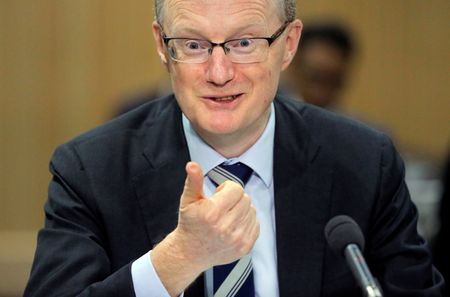SYDNEY (Reuters) -The head of the Reserve Bank of Australia (RBA) reiterated on Wednesday that interest rates had not peaked, adding that he was unsure how high they had to go as the central bank, seeking to control inflation, tried to follow a narrow path to a soft landing.
Getting there, and avoiding a recession, depended on moderation in wage rises, RBA Governor Philip Lowe told members of parliament.
Despite a series of interest rate rises that began in May, consumer price inflation hit a 32-year high in the fourth quarter.
“Inflation at the moment, 7.8%, is way too high. It needs to come down. That’s our primary consideration,” Lowe said.
When asked about how far interest rates would have to rise, he said policymakers had an open mind.
“I don’t think we’re at the peak yet but how far we have to go up I don’t know,” he said, adding that the central bank would keep monitoring inflation, consumer spending, the global economy and wages growth.
The RBA was not trying to push the economy into a recession, and a narrow path to a soft landing was available if wage rises stayed reasonable, he said. The risk of a spiral of wages driving up prices then prices driving up wages was relatively low, he said, but if it happened the costs would be high.
Wages in the third quarter were 3.1% higher than a year before.
The central bank has lifted its policy rate by 325 basis points since May to a decade high of 3.35%.
“There is a risk that the tightening of policy that’s taken place does dampen spending more than we think,” Lowe said. “We don’t have a perfectly clear crystal ball.”
“But there is a risk on the other side. There is a risk that we have not yet done enough with interest rates and spending is more resilient and that inflation stays high.”
“So the risks are two-sided and we’re trying to navigate our way through a narrow path. I understand why some people focus on the risks on the one side but we’ve got to be attentive to the risk from higher inflation.”
MARKETS SEE HIGHER PEAK
The RBA most recently implemented an interest rates rise on Feb. 7 and said more would come. Markets responded by raising the expected peak for the policy rate to around 4.2% from 3.6% a month before, implying there would be at least three more rises.
A shock fourth-quarter inflation report issued on Jan. 25 showed consumer prices had been 7.8% percent higher than a year earlier. A closely watched measure of inflation – the trimmed mean – was up 6.9%, exceeding the RBA’s forecast for a 6.5% rise.
The central bank later said that, even though inflation had likely peaked in the fourth quarter, domestic cost pressures were still strengthening. That implied resilience in future inflation.
The RBA forecasts that inflation will be back in its target range of 2% to 3% by mid-2025.
“We want to get inflation down because it’s dangerous,” Lowe said on Wednesday. “It’s corrosive, it hurts people, it damages income inequality and it if stays high it leads to higher interest rates and more unemployment.”
“Raising interest rates has always been unpopular … but our job is to make sure inflation comes down and hopefully preserve the gains of employment that we have made.”
The unemployment rate was 3.5% in December, near a five-decade low.
(Reporting by Stella Qiu; Editing by Christopher Cushing and Bradley Perrett)

